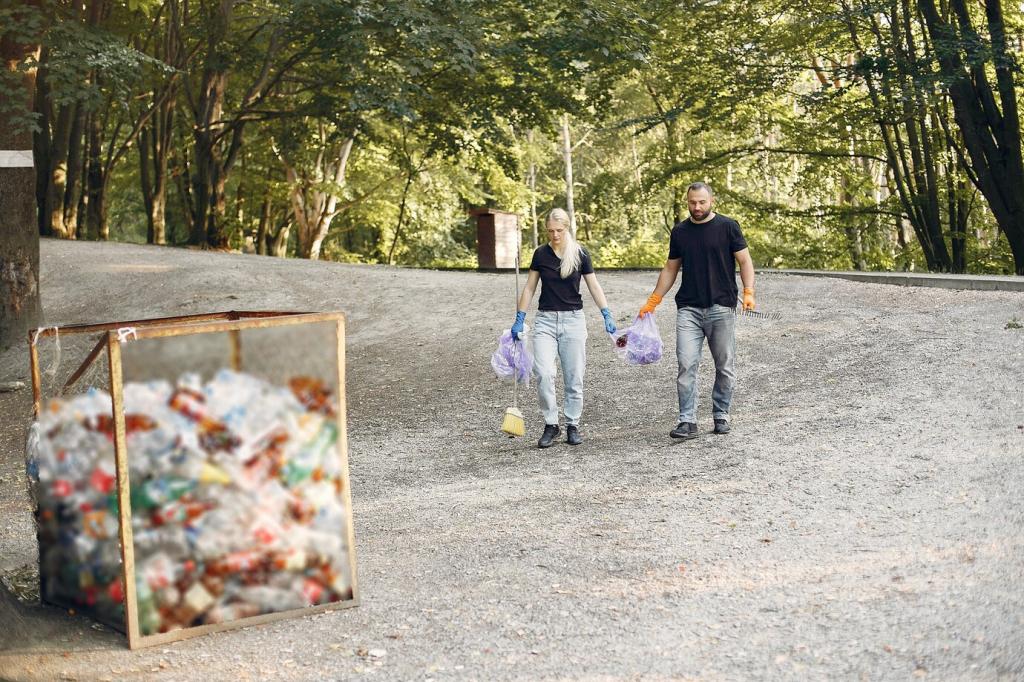Urban Vermicomposting Solutions
Urban vermicomposting offers a sustainable, space-efficient method for converting kitchen scraps and organic waste into nutrient-rich compost. This innovative solution is particularly suitable for city dwellers, where outdoor space is often limited and minimizing landfill contributions is increasingly critical. Embracing vermicomposting in urban environments helps close the nutrient loop, supports healthier gardens or potted plants, and reduces the environmental impact associated with conventional waste disposal. This page explores the core concepts, practical considerations, and environmental benefits of urban vermicomposting systems, equipping you with knowledge to cultivate richer soil while fostering a greener urban lifestyle.

Worm Biology and Role in Composting
Composting worms, such as red wigglers, have a unique biological capacity to consume and process organic matter rapidly. As they digest kitchen scraps, their bodies extract nutrients, and what they excrete is called worm castings—a dark, crumbly material loaded with beneficial microbes and plant-available nutrients. The worms’ constant movement aerates the compost, reducing odors and speeding up decomposition. Proper care involves maintaining optimal moisture, temperature, and dietary diversity to keep the worm population thriving. By focusing on worm health, urban composters ensure steady, efficient conversion of waste into rich, usable compost.
Composting Science in Urban Settings
Urban environments present distinct challenges for composting, including smaller spaces and potential concerns about pests or odors. Vermicomposting provides an elegant solution by allowing the process to take place indoors, often in compact and contained bins. The scientific principles at work involve maintaining the correct carbon-to-nitrogen ratio, ensuring sufficient aeration, and preventing conditions that favor harmful bacteria or pests. When done correctly, urban vermicomposting is virtually odor-free and yields a constant supply of high-quality compost that benefits rooftop gardens, balconies, and houseplants.
The Nutrient Cycle and Waste Reduction
Vermicomposting plays a key role in closing the nutrient loop within cities. Rather than discarding organic waste to landfills, where it decomposes anaerobically and produces methane—a potent greenhouse gas—vermicomposting transforms waste into a valuable resource. The resulting compost improves soil fertility and structure, which is especially important in urban settings where access to quality soil can be limited. By returning nutrients to the earth, city residents contribute to healthier urban ecosystems and reduce their carbon footprint, all while fostering a more sustainable relationship with the environment.
Choosing the Right Vermicomposting System
Apartment-Friendly Vermicomposting Bins
For apartment residents, space-saving design is paramount. Compact bins—often stackable and crafted from durable, non-toxic materials—fit under sinks, in closets, or on balconies. These bins use tiered systems that optimize the vermicomposting process by separating fresh waste from finished compost and enabling easy harvesting of castings. Some popular models incorporate tap drains to collect nutrient-rich worm tea for houseplants. Careful placement ensures optimal temperature and ventilation, while thoughtful design controls moisture and aeration. With proper attention to maintenance and worm diet, apartment dwellers can successfully transform daily food scraps into premium organic fertilizer without compromising living space or comfort.
Indoor and Balcony Setups
If your urban dwelling includes a small balcony or sunroom, you have flexibility to experiment with larger or more personalized vermicomposting setups. Weather-resistant bins can be used outdoors, provided they’re shielded from extreme temperatures and direct sunlight. Indoor setups benefit from controlled environments, reducing seasonal variables that affect worm activity. Customizing bin size and aesthetics allows integration of vermicomposting into your décor, making it an accessible and attractive addition to daily life. Whether you choose a store-bought system or build your own, attention to insulation, drainage, and airflow ensures worms remain healthy and productive year-round.
Community-Based Compost Solutions
For residents without sufficient space or those interested in collective solutions, community vermicomposting offers a way to participate in broader sustainability efforts. Shared bins placed in common areas or community gardens can handle larger amounts of organic waste while involving multiple households. These systems often require collaborative management, rotating responsibilities for feeding, harvesting, and maintaining the bin. Community-based composting not only diverts substantial waste from landfills but also fosters neighborhood engagement and education around environmental stewardship, building social ties through shared ecological purpose.
Sourcing Composting Worms
The foundation of a fantastic vermicomposting bin starts with obtaining the right type of worms. Red wigglers (Eisenia fetida) are the species of choice due to their voracious appetites and resilience in confined spaces. Purchasing worms from reputable suppliers guarantees healthy stock less likely to introduce pests or diseases. If local availability is limited, many suppliers offer mail-order shipping. It is important to acclimate worms to their new environment gradually, introducing small amounts of bedding and food until they adjust. Ensuring worms have a safe, moist, and dark environment encourages them to settle and begin processing organic waste efficiently.
Setting Up Your Vermicomposting Bin
Proper setup of your bin determines long-term system success. Start by layering moist bedding material—such as shredded newspaper, coconut coir, or aged leaves—to provide structure and absorbency. Add food scraps in moderation, focusing on fruit and vegetable peels, coffee grounds, and eggshells, while avoiding dairy, meat, and oily foods that attract pests or create odors. Maintaining optimal conditions involves checking for excess moisture, preventing overcrowding, and regularly fluffing the bedding to enhance aeration. With consistent care, worms will process waste steadily, and within a few months, you’ll have valuable compost ready for harvesting.
Feeding and Maintenance Routines
Developing a simple yet effective routine for feeding and maintaining your vermicomposting system is essential. Feed worms small amounts of kitchen scraps every few days, observing their consumption rate and adjusting input accordingly so no food lingers uneaten for too long. Always bury food under bedding to deter flies. Maintain consistent moisture by misting as needed, and monitor for signs of stress, such as foul odors or worm escape attempts—both indicators of imbalance. Every few months, separate finished compost from worms and refresh the bin with new bedding. This cycle ensures a healthy worm population and a perpetual supply of garden gold.
Overcoming Common Urban Challenges

Concerns about bad smells and pests are common among prospective urban vermicomposters. Fortunately, a well-maintained bin emits little to no odor: if a strong smell develops, it typically signals overfeeding or excessive moisture. Remedying these issues involves removing excess food, balancing wet and dry materials, and gently turning the bedding. To deter fruit flies, always bury food scraps and cover the surface with a layer of damp newspaper or cardboard. For persistent infestations, temporarily relocate the bin or introduce beneficial nematodes. Regular vigilance and prompt corrective action keep vermicomposting discreet and neighbor-friendly.
Harvesting and Using Vermicompost
Timing the Harvest
Knowing when to harvest is crucial for system productivity. Mature vermicompost appears dark, fine-textured, and largely free of recognizable food scraps—achieved after two to four months in most active bins. To separate compost from worms, employ a simple migration technique by moving fresh bedding and food to one side, encouraging worms to leave the finished material for easier collection. Regular harvesting creates more space for further decomposition, maintains air circulation, and prevents overpopulation, ensuring the ongoing health of your worm colony.
Applying Vermicompost to Urban Gardens
Vermicompost is renowned for its potency and ease of use. Rich in nutrients and beneficial microbes, even small quantities dramatically enhance the growth of potted plants, window boxes, or rooftop vegetable gardens. Mix vermicompost into potting soil, sprinkle it as a topdressing, or brew worm tea for liquid feeding. The slow-release nutrient profile supports healthy root development and improves moisture retention, making urban gardens more resilient and productive. By recycling your own organic waste, you foster a closed-loop, eco-friendly gardening system tailored to city environments.
Sharing and Repurposing Surplus
If your vermicomposting system produces more compost than you need, consider sharing the surplus with neighbors, local gardening clubs, or community gardens. Vermicompost makes a thoughtful and sustainable gift, promoting environmental awareness and building community bonds. Alternatively, offer excess worms to newcomers eager to start their own systems. By repurposing surplus outputs, you extend the benefits of vermicomposting beyond your household, catalyzing broader adoption and urban sustainability.
Environmental and Economic Benefits
Reducing Landfill Waste and Greenhouse Gas Emissions
A large percentage of municipal waste consists of compostable materials, much of which ends up in landfills, decomposing anaerobically and emitting methane. Vermicomposting diverts this waste stream, reducing landfill volume and lessening the release of potent greenhouse gases. When widely adopted across urban areas, the collective impact can be profound, making vermicomposting a simple yet effective weapon against climate change and waste management challenges.
Supporting Local Food Production
Urban gardening is on the rise, but achieving healthy, productive crops often means importing bags of fertilizer and soil amendments—which come with their own environmental costs. Vermicompost replaces store-bought fertilizers with a homegrown alternative tailored to the needs of your indoor or rooftop garden. Increased soil fertility from worm castings supports robust vegetable, herb, and flower growth, enhancing food security and community self-reliance. By nurturing plants with homemade compost, urban dwellers enjoy tastier harvests and closer connections to their food sources.
Cost Savings for Urban Households
Over time, urban vermicomposting can yield meaningful financial benefits. By making your own compost, you eliminate the need for commercial soil additives and houseplant fertilizers. Reduced reliance on garbage bags and landfill services may further decrease household waste fees. Some municipalities offer incentives or discounts on composting equipment, and surplus worm castings can even be sold or traded locally. The modest setup costs of a worm bin quickly pay off in savings, aligning environmental responsibility with your household budget.

Education and Community Engagement
Workshops hosted in schools, libraries, or community centers introduce participants to the basics of worm composting through hands-on demonstrations. These sessions dispel myths, address common concerns, and provide tips for troubleshooting. By empowering individuals to start their own bins and educating them on sustainable waste management, communities lay the groundwork for lasting behavioral change. Skill sharing helps demystify composting, making it approachable and actionable for city residents of all ages.
